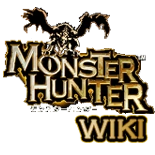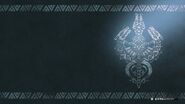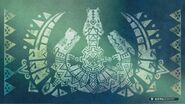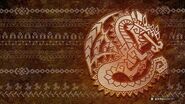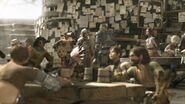The Hunter's Guild (Japanese: ハンターズギルド, Hantāzu Girudo) is the central governing association in Monster Hunter.
Goals and Policies[]
The Hunter's Guild is the central governing association in Monster Hunter, in pursuit of a common goal. Its main purpose is preventing the ecosystem from being further damaged, in an attempt to prevent extant species from becoming extinct. It intends to coordinate humans with nature, despite the two having become separated over millennia. To enforce this policy, the Guild uses trained experts called hunters. The populations of monsters in each region are recorded, and hunters are not allowed to repeatedly hunt the same species unless otherwise stated. Poaching can result in a multitude of punishments, but the most common is death at the hand of a Guild Knight.
The Four Swords of the Guild[]
The crest of the Hunter's Guild contains four symbols, representing the four values that the association attempts to uphold. The highest symbol represents ‘respect for nature’, the left symbol represents ‘life as a community,’ the right symbol represents ‘prosperity from nature’, while the lowest symbol represents ‘crafting from nature’.
Services and Responsibilities[]
The Hunter's Guild unifies and regulates all hunting activities. It collects hunting and gathering requests from all over the world, posting them within their gathering halls and outposts for hunters to undertake. There are many purposes to such tasks, such as keeping people and towns safe from harm, or researching the anatomy and biology of monsters. On certain occasions, such as an elder dragon attack or the discovery of a new species, the Guild itself will issue a hunting request to a specific range of hunters. It keeps a comprehensive list of all known monster species and variations, and will provide hunters with this information on a regional basis.
Furthermore, the Hunter's Guild is responsible for determining areas can be embarked upon when hunting. It will sometimes restrict which hunters can enter certain areas. Finally, the Hunter's Guild will build colosseums and arenas for controlled fights between hunters and monsters to occur. They are typically used for training purposes, but also for the entertainment of the public.
Locations[]
The headquarters of the Hunter's Guild are located in the city of Dundorma, and all major announcements and actions are made from this location. The Guild commands a sprawling territory, comprising of numerous districts, each of which is managed by a Guild Master, located in multiple regions. The primary districts of the Hunter's Guild are Minegarde, Dundorma, Loc Lac, Tanzia, and Val Habar. Smaller outposts are set up in remote towns and villages, with lower populations, such as Kokoto Village, Pokke Village, Moga Village, and Yukumo Village, and are handled by one or more Hunter's Guild-employed representatives. These are considered to be a part of the larger districts. For example, Pokke Village belongs to the Dundorma District, and Yukumo Village belongs to the Loc Lac District. Each district manages its own hunting grounds, and some share grounds.
Registration[]
In order to undertake quests from the Hunting Guild, one must register themselves as a Monster Hunter. Following this, each hunter is given a specific measure of personal skill, or their ‘Hunter Rank’, through which the Guild can determine one's ability to complete varying levels of requests. The Guild will also assign rankings to quests, ensuring that only those with the correct practice will carry out such tasks.
Each hunter is also given a Guild Card, which can have its design changed at their own freewill. This is used as a method of identification for hunters, as it lists their name, custom title, what tasks they have completed, what awards they've collected, and the species that they have hunted. The cards are typically made from wood, ore, or the body parts of monsters.
Captured Monsters[]
When a monster is captured, it is typically killed in its sleep by the institution that requested it. This so its organs and other body parts can be observed, allowing them to improve their understanding of a particular species. Such institutions include the Elder Dragon Observation Team, the Wycademy, and the Royal Palaeontology Scriveners. In Astera, a captured monster may have a few body parts removed if necessary, but it is typically studied and released.
Gallery[]
Sources[]
- "Hunter's Encyclopedia 1"
- "Hunter's Encyclopedia 2"
- "Hunter's Encyclopedia G"
- "Hunter's Encyclopedia 3"
- "Hunter's Encyclopedia 4"
- Monster Hunter
- Monster Hunter G
- Monster Hunter Freedom
- Monster Hunter 2
- Monster Hunter Freedom 2
- Monster Hunter Freedom Unite
- Monster Hunter 3 Ultimate
- Monster Hunter 4 Ultimate
- Monster Hunter Generations
- Monster Hunter XX
